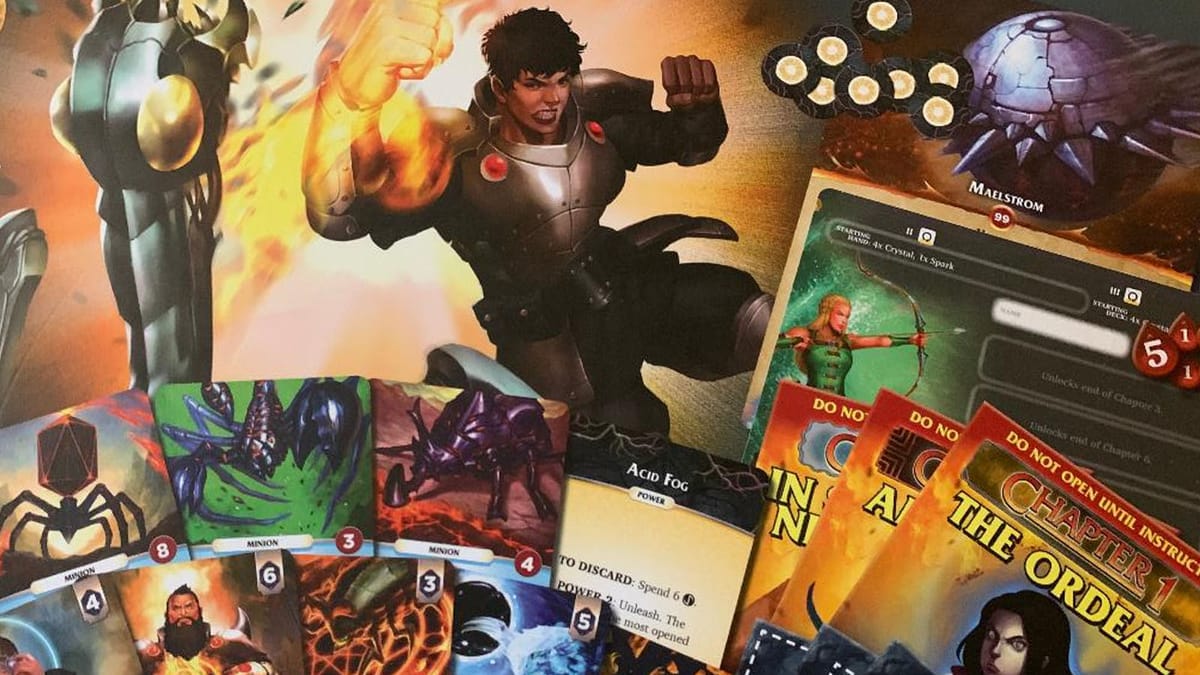
Before I get started, I wanted to make sure everyone understood that first I will explain the game with no major spoilers and give my overall opinions of the game and its mechanics. I will then discuss some details in a marked spoiler section for those interested in those thoughts as well.
Aeon’s End Legacy is a cooperative deck building game for 1-4 players designed by Kevil Riley and Nick Little and published by Indie Boards & Cards. In this game, players will take on the roles of breach mages which harness the power of these breaches to cast spells to overcome the enemies.
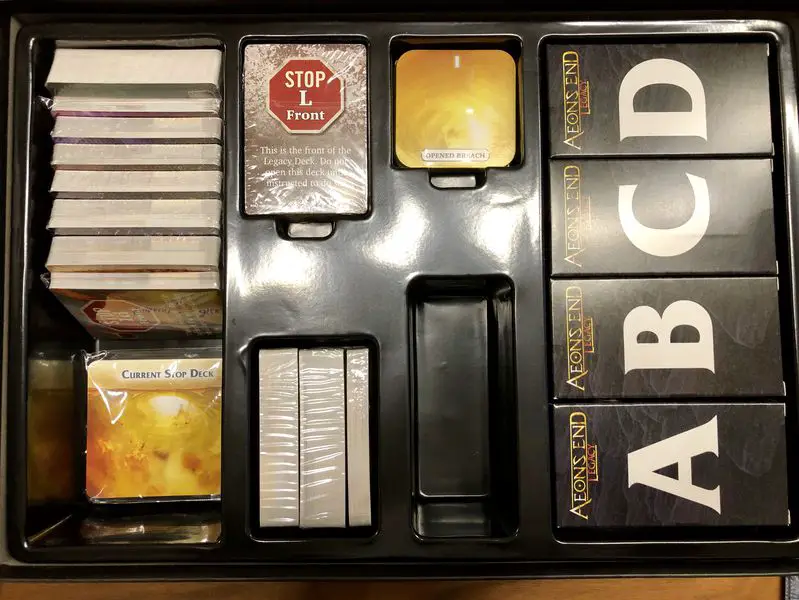
Aeon’s End Legacy was my first legacy game and when I opened the box, it filled me with excitement. Seeing all the envelopes, sealed decks of cards, and mystery boxes added to my excitement even more. The game gives a clear sheet that explains how players should set up the first game and the rulebook is written very well to detail how the base game is played. I had never played Aeon’s End before but thankfully the game explains everything and points out the differences in this version. The legacy deck also walks players through the story and what to do for each game.
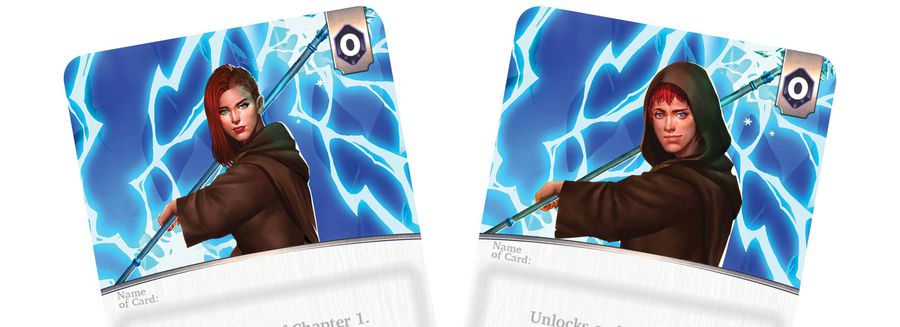
The two choices for one of the mages
Players will choose from one of the four different breach mages which are double sided if you want to choose a girl or a guy and they get to name their characters. It will then give players a starting deck with the standard cards used for purchasing called aether and spell cards used for damage. One difference about this game, however, is that the order of the cards matter. In traditional deck builders, the deck is shuffled and each time you draw a card you never know what the next one will be. Aeon’s End Legacy is different though. Your starting deck is placed in a specific order and while you can play cards in any order, once your deck is exhausted you just flip your deck over and draw from the top. This means the first card you played will now be the first card you draw. This allows players to group their cards in a specific way as they play them to plan ahead.
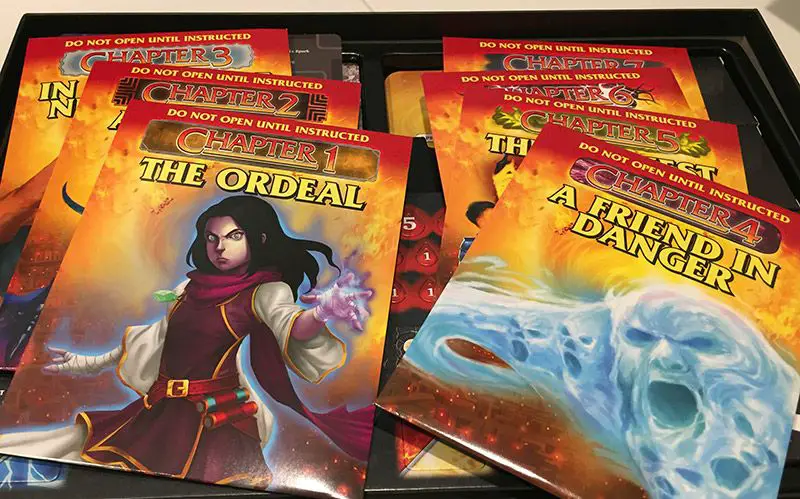
All the Chapters laid out
Another difference in this game compared to other deck builders I’ve played was that you aren’t required to play all the cards in your hand and sometimes you can’t if there isn’t anything to spend your remaining aether on. At the end of your turn you instead draw additional cards until you reach five cards total.
Dealing damage is slightly different in this game and you must prep your spells which will then either automatically fire off at the start of your next turn if you haven’t spent the aether to unlock them or you can decide to keep them prepped if they are on an open breach and decide again on your next turn. Turns are another thing which Aeon’s End Legacy does different from other games I’ve played. Instead of there being a set order, the enemy known as the Nemesis has two cards and in my two player game we each had 2 cards. These 6 cards are shuffled and then each turn a new card is flipped over to show whose turn it is.
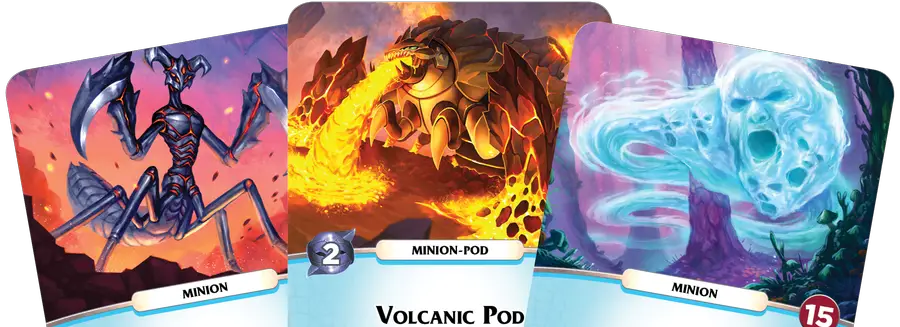
Beautiful minion artwork
When the nemesis card is flipped, cards from their specific deck are flipped and actions on them are carried out. There are also specific unleash actions listed on the bosses board which are carried out based on the scenario. Sometimes a card will come out with the word power on it. These cards are always bad, but usually give you some time to try to prevent these bad things from happening by performing an action. If these actions can be completed in time, the card will be discarded, otherwise even more bad stuff will happen.
Play will continue until players have either defeated the boss or endured all the cards from the boss’ deck to win. Players will lose if all players lose their health or if the town loses all its health. One thing to note is that if one player loses their life, it doesn’t mean that person is out. Instead, they will continue to play but under some new rules. This means there is no player elimination for having a bad game. At the end of the game the legacy deck will walk players through what they should do if they won or lost and will explain what to do next.
Overall, I really enjoyed the gameplay of Aeon’s End Legacy. The idea of trying to fight a big boss while dealing with little minions is fun. Deck building games are some of my favorite games with some of my other favorites being Marvel Legendary and Clank. This game allowed me to customize my deck as I went and let me play the way I wanted which was fun. The artwork on the cards is amazing and looking at some of these creatures I can only imagine facing them in battle. The different cards that were available to purchase were also interesting as they continued to help you shape your deck to what you wanted.
When you think of a legacy game, the big thing that draws you in is the story. Unfortunately, I felt the story was one of the biggest letdowns of the game. The initial setting of the story was fine, and I felt a real sense of urgency through the start of the game, however as it continued it became very predictable and almost obvious. Sometimes they did so much foreshadowing that they left little doubt or twist as to what would happen next. Only once or twice was I surprised by what came next which really let me down.
The other issue I had with the game was that while certain aspects of the theme were a big part of the game, other times the mechanics made it feel like a game instead of a story. These choices removed the immersion from the story and put me back in the game. New mechanics were introduced with what seemed like zero story thought and put a bad taste in my mouth.
Another issue I had was with the turn order deck. Trying to shuffle 6 cards is very annoying and numerous times I felt like it was impossible to do a good shuffle. I resorted to using a website I found online that drew the cards and saved me time from having to shuffle and also felt like it improved the randomness. The other issue I had with the turn order deck was that it felt like regardless of how much planning you did, if you got bad draws there was nothing you could do. In one of my games I prepared for everything on the board and 3 Nemesis turns in a row caused everything I did to be destroyed. While this is part of the randomness of the game it doesn’t allow for any strategy to prevent it.
My final issue with the legacy aspect of the game was that it felt unpolished. It shouldn’t be spoilers to know that stickers and items come out to change the game. Many of the times, the stickers that are in the game don’t fit the spots at all and hang off, looking terrible or they’re too small. This seems like a simple thing to verify and this made it feel cheap.

The initial introductory chapter was fine as it helped explain the basic mechanics of the game and helped to move the story forward. As soon as the first game ends, the initial deck customization begins which is nice. With all the options and not knowing what is coming next, it can be a little difficult to decide which to choose, but me and my daughter decided for me to specialize in doing damage and she would specialize in being able to purchase support cards. The second game immediately stressed the need to have someone with the ability to get a large amount of aether to stop the power cards from going off. I hadn’t expected this and so the game was a little tight but we still came out with the win.
As we continued to move on, a new concept of evolve was introduced. While in theory this mechanic is awesome and throughout the game there were some cases where I liked how they used evolve, there were others that seemed odd. In one case, a card would evolve just from not eliminating it and it having time to grow. This made thematic sense and it was cool to see the larvae turn into something bigger and grow. It added weight to my choices about what to focus on. There were some evolve cards however, which felt so generic and put a bad taste in my mouth immediately. When a card is flipped over and says, “If this is Chapter 4 evolve this card” it breaks the immersion. There are other ways that this could have been handled such as saying “if boss xyz was defeated then evolve this card”. This would give a flow and then when the new card came out the story would continue.
Continuing through the game the issue with the lack of ability to plan ahead really began to become a problem. In chapter 4 the silence mechanic is introduced and while I like the mechanic there are times when all the enemies are silenced but three nemesis turns in a row not only unsilence them but cause them all to attack. Without the player’s turn in between these nemesis turns it eliminates the ability to plan ahead. This game ended up being the closest to date and was beaten by enduring the nemesis deck. That was one thing about the game I wasn’t expecting. In many games if you don’t beat the boss before the deck runs out you lose, but this game had an alternate victory condition. In many cases it was easier to endure the deck instead of fighting the boss.
Chapter 5 was by far my most disliked chapter of the game. At the start of the game the story essentially says “You now feel more powerful”. With little to no story or build up the game just gave you super powers. Where was the story to make this feel eventful? This chapter also felt like it was there to cripple players and make it generally harder. I don’t mind crippling the players to make it harder but it felt generic and unfair where I feel there could have been other ways to handle this.
The game continued and remained entertaining as the different bosses all required different strategies to defeat. One might need big amounts of damage while others require pinging the damage around. After defeating the final boss, the biggest unkept secret occurred and Xaxos turns evil. Throughout the whole game there wasn’t even a doubt that Xaxos wasn’t going to try to use the power for evil as over and over again in the story he suggested it and would then disappear. This put the final nail in the coffin for me for the support of the story writing.
Aeon's End Legacy
All Right
While the aesthetics and variety of the monsters and the general gameplay are fun, the story which should be one of the most important parts of a legacy game is lacking. Some mechanical choices also hinder players’ ability to strategize.
Pros
- Beautiful aesthetics
- Unique deck building gameplay
- Continuing changing strategies
Cons
- Generic story
- Turn order deck issues
- Legacy elements not uniform
- Mechanics remove immersion
